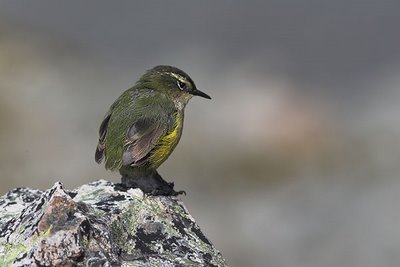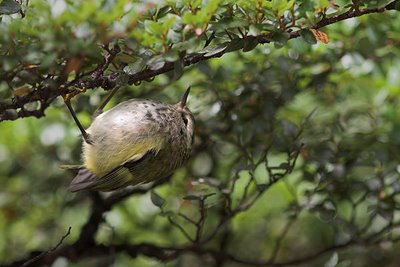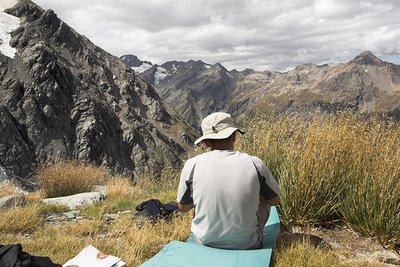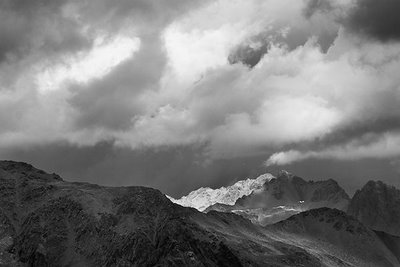 Sometime before dawn, in that half light when night and day still struggle, I got up, ate breakfast and drove off; drove South on empty roads from Kaka Point into the Catlins. Mist filled the valleys and hollows, a diffuse fog with hazy boundaries, softening silhouettes, muting colours. I stopped, took a couple of photos, carried on; stopped again to photograph the old sheds filled with hay and machinery by the Owaka intersection. The sun had burned away most of the fog; the early morning light, now direct and unfiltered but still low and warm, accentuated colours and picked out details like the long, dry grass in front of a dark, doorless opening; the hard angles of an arcane farm implement; the texture of old corrugated iron, paint faded and peeling. Despite their air of age and abandonment, of countless stories and enormous possibility, the sheds projected authenticity—these were sheds in use, even if the use was infrequent.
Sometime before dawn, in that half light when night and day still struggle, I got up, ate breakfast and drove off; drove South on empty roads from Kaka Point into the Catlins. Mist filled the valleys and hollows, a diffuse fog with hazy boundaries, softening silhouettes, muting colours. I stopped, took a couple of photos, carried on; stopped again to photograph the old sheds filled with hay and machinery by the Owaka intersection. The sun had burned away most of the fog; the early morning light, now direct and unfiltered but still low and warm, accentuated colours and picked out details like the long, dry grass in front of a dark, doorless opening; the hard angles of an arcane farm implement; the texture of old corrugated iron, paint faded and peeling. Despite their air of age and abandonment, of countless stories and enormous possibility, the sheds projected authenticity—these were sheds in use, even if the use was infrequent. Later that morning I drove past an older, wooden barn standing, prominent and obvious, boards broken and weathered, near the roadside.  At first glance it seemed full of character, but as I drove past I realised it seemed too full of character, as if it had been left there deliberately so tourists could photograph it and exclaim, “What a wonderful old barn!” It seemed too much a statement; something left on purpose to add a complementary human element to the landscape. In a moment, my impression went from appreciation to dissatisfaction—this barn lacked the authenticity of the sheds I’d photographed earlier.
At first glance it seemed full of character, but as I drove past I realised it seemed too full of character, as if it had been left there deliberately so tourists could photograph it and exclaim, “What a wonderful old barn!” It seemed too much a statement; something left on purpose to add a complementary human element to the landscape. In a moment, my impression went from appreciation to dissatisfaction—this barn lacked the authenticity of the sheds I’d photographed earlier.
Of course, the facts are likely to be completely at odds with my impressions, and this barn might still be used for some genuine farming purpose, even if simply storing hay; and I’m sure its owner hasn’t left it standing primarily—or even at all—as something for tourists to appreciate. These were simply my impressions.
 I began to wonder whether authenticity—something valued so greatly by so many people, perhaps especially tourists and travellers—is mainly a function of purpose. A shed used to support the farm, or other way of life of its owner, has an authenticity far greater than an otherwise functionless shed left standing because tourists like the look of it. At the other extreme, a shed built last year and designed impeccably for its purpose (storing equipment; shearing; workshop, etc.) may be totally functional but is largely devoid of interest—“character”, I suppose—until it has accumulated enough age and stories; until it has gathered enough dust and clutter to hide at least a few interesting things.
I began to wonder whether authenticity—something valued so greatly by so many people, perhaps especially tourists and travellers—is mainly a function of purpose. A shed used to support the farm, or other way of life of its owner, has an authenticity far greater than an otherwise functionless shed left standing because tourists like the look of it. At the other extreme, a shed built last year and designed impeccably for its purpose (storing equipment; shearing; workshop, etc.) may be totally functional but is largely devoid of interest—“character”, I suppose—until it has accumulated enough age and stories; until it has gathered enough dust and clutter to hide at least a few interesting things.
Perhaps you might dismiss what I’m saying as just semantics—you might argue I’m just defining words like “authenticity”, “purpose”, and “function” to suit my argument.  But I don’t think I am; I’m not trying to argue a point, what I’m trying to do is explore an idea, a concept that seems real to me. Unfortunately, this requires words, and the words most useful for this already have their own meanings; meanings that differ, subtly or substantially, for everyone who uses them. This is the weakness of words. It’s also their power.
But I don’t think I am; I’m not trying to argue a point, what I’m trying to do is explore an idea, a concept that seems real to me. Unfortunately, this requires words, and the words most useful for this already have their own meanings; meanings that differ, subtly or substantially, for everyone who uses them. This is the weakness of words. It’s also their power.
...
Further along the coast I stopped briefly at the Florence Hill lookout, to be instantly swarmed over by sandflies [1], so I continued South to Curio Bay. About once every half an hour or so, another car drove past going North; otherwise, for the first couple of hours I had the whole of the Catlins to myself—so it seemed.  The crowds hadn’t arrived at Curio Bay, but by the time I left, a few people had drifted in, wandered about briefly, then left. No one seemed to take much time to feel the place, touch the land; everyone seemed to do no more than look. Briefly.
The crowds hadn’t arrived at Curio Bay, but by the time I left, a few people had drifted in, wandered about briefly, then left. No one seemed to take much time to feel the place, touch the land; everyone seemed to do no more than look. Briefly.
I cruised slowly to Slope Point [2]. Several cars and campervans had already arrived, but by the time I’d organised myself, some had left, leaving me feeling relaxed and uncrowded. Then four cars arrived in convoy, and 8 people got out. They walked in pairs, side by side, like a small platoon; marched to the Lighthouse, peered over the edge of the cliff, and took turns photographing each other standing next to or leaning over the sign—“Equator: 5140 km” pointing North, “South Pole: 4803 km” pointing South. Having done Slope Point, they marched back to the cars.
I sat for a while on a small shelf just down from the edge, sometimes looking at the silhouette of Rakiura (Stewart Island)— the first time I could recall seeing it clearly—but mostly thinking about the sea, and about sitting as far South as I could go on the South Island. I’d felt something similar years ago on the Surville Cliffs, the northernmost part of the North Island. No more New Zealand out there. Now, looking South, save for a few small islands, there was nothing between me and Antarctica. Out there, only sea—the great Southern Ocean; icebergs; wild light on albatross wings; petrels; penguins; fewer and fewer whales. A vast ocean, teeming with life, much of it still unknown, most of it alien to me. Beautiful, strange—and sometimes terrifying. Below me, a deep swell rolled in, heaved and burst against the rock platform—a huge roar, an explosion of white foam, bull kelp [3] writhing and flailing.
the first time I could recall seeing it clearly—but mostly thinking about the sea, and about sitting as far South as I could go on the South Island. I’d felt something similar years ago on the Surville Cliffs, the northernmost part of the North Island. No more New Zealand out there. Now, looking South, save for a few small islands, there was nothing between me and Antarctica. Out there, only sea—the great Southern Ocean; icebergs; wild light on albatross wings; petrels; penguins; fewer and fewer whales. A vast ocean, teeming with life, much of it still unknown, most of it alien to me. Beautiful, strange—and sometimes terrifying. Below me, a deep swell rolled in, heaved and burst against the rock platform—a huge roar, an explosion of white foam, bull kelp [3] writhing and flailing.
The sea. Where we all came from. The mother of us all.
Notes:
1. They're known elsewhere in the world as blackflies (Simuliidae). All New Zealand species belong to the genus Austrosimulium.
2. The hyperlink to Slope Point shows you where it is, but incorrectly states it's in Akaroa County (according to the site, everywhere in NZ is in Akaroa County, or in a place called "None". Yeah, right). In fact, Slope Point is in the Southland Region (here's some info about Southland's coastal environment).
3. Durvillea antarctica.
Photo 1: Female ngirungiru (miromiro in the North Island), the tomtit (Petroica macrocephala); Arthur's Pass.
Photo 2: Male rock wren, piwauwau (Xenicus gilviventris), near Sefton Biv.
Photo 3: Titipounamu, the rifleman (Acanthisitta chloris), gleaning at Arthur's Pass.
Photo 4: Jonathan browsing the hut book at Sefton Biv...
Photo 5: ... and resting in the afternoon sun; the tail of the Mt Cook Range in the distance .
Photo 6: This is usually not the weather you want to see in the mountains. Evening light on the Mt Cook and Liebig Ranges, from Sefton Biv.
Photos and words © 2006 Pete McGregor
11 comments:
Pete, you have the gift of putting into words what some of us feel but can't express, long may you blog. Pictures aren't half bad either! Ten out of ten.
Lova all of it... but especially the fluffy little birds. :)
Duncan, it's my hope — and my belief — that a great many people feel the same way, and it's always a great feeling to discover that what I write about elicits such positive responses. It's like an affirmation: that despite the ills of the world, there are still so many good people out there. Thanks for your encouragement :^)
Rurality, I'll reiterate what I've just said to Duncan; and I'm pleased you enjoyed the wee birds. Seeing them, so fragile yet so resilient — so at home — is the sort of joy you can get lost in. Thanks for the comment :^)
Pete-- I am touched most by your looking south from as far south as land goes, and nothing left between you and Antarctica. The thought of light on an albatross wing, or a penguin diving beneath the waves there is so moving. I don't know why it reminds me of my own longing for aloneness. The crowded earth-- heavy with people and cars, and barns left for ambiance-- pushes me to the fringes looking for perfect air to fill my lungs.
RD: You've said that so wonderfully. Life on the fringes; on the edge of things... sometimes, high on a mountain, I look around and almost everything's below my feet: that's another sort of edge. (Then, of course, there are the figurative meanings of "edge", "fringe", and "boundary"...) These are special places. Places that say so much, yet places without words.
I love your posts- it has been a dream of mine to visit New Zealand for many years, but I doubt I could climb to the vistas you graciously share. I appreciate both the words and photos. (I have never viewed a rock wren in breeding plumage, what a beauty!)
and as Duncan said so well.. blog on!
Thanks Cindy! I can hardly wait to get back down South and meet up with these little wrens again. There's something so immediately appealing about them: not just how they look, but their behaviour as well. They seemed almost to be encouraging me; as if they were as interested in me as I in them.
Right, I'd better blog on then...;^)
Beautiful, why NZ doesn't look like Middle Earth at all! (sorry, couldn't resist.)
Fluffy wee birdies and stunning geography.
Could be the picturesque shed is both functional and pretty- in it's owner's eyes
Ha! :D Of course, one of the things that makes NZ so attractive to filmmakers is not simply that we have spectacular landscapes, but that we have such a diversity of landscapes, all within a small country. I'm very lucky...
Yes, well said, Zhoen: perhaps "authenticity" is greatest when the distinction between being functional and being aesthetically pleasing is artificial and arbitrary.
Achhh! Don't get me started on blackflies!
But back to the sheds and barns...
We humans are essentially egotistical, and the yawning, sagging sheds of our past work and glory are perhaps just indicators of our passing through; they are evocative as opposed to utilitarian? Their purpose has evolved, and we can't stand the fact that they are now, more or less, somewhat useless except for our existential rationalizing.
Oh blather....
Wonderful post, Pete!
I think it's one of the things I like about old sheds, Trix: by reminding us that we're ephemeral, they remind us to practise being humble; to try to be less egotistical. And I do like the way an object's purpose can evolve. As its purpose changes, it accumulates more stories. What I do find sad is when a new purpose somehow conflicts with or detracts from an older function — akin to what I imagined about the second barn with its sense of diminished authenticity.
Now I'm blathering... ;P Thanks for the thoughts, Trix.
Post a Comment